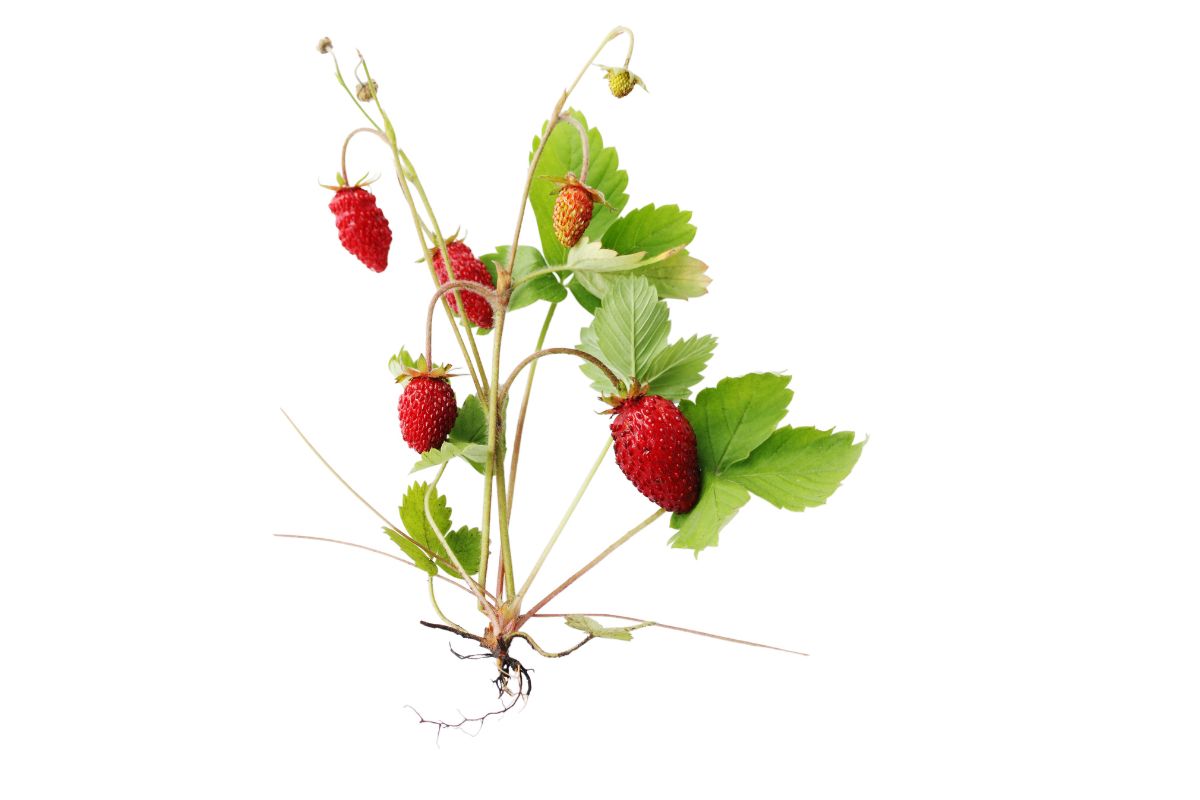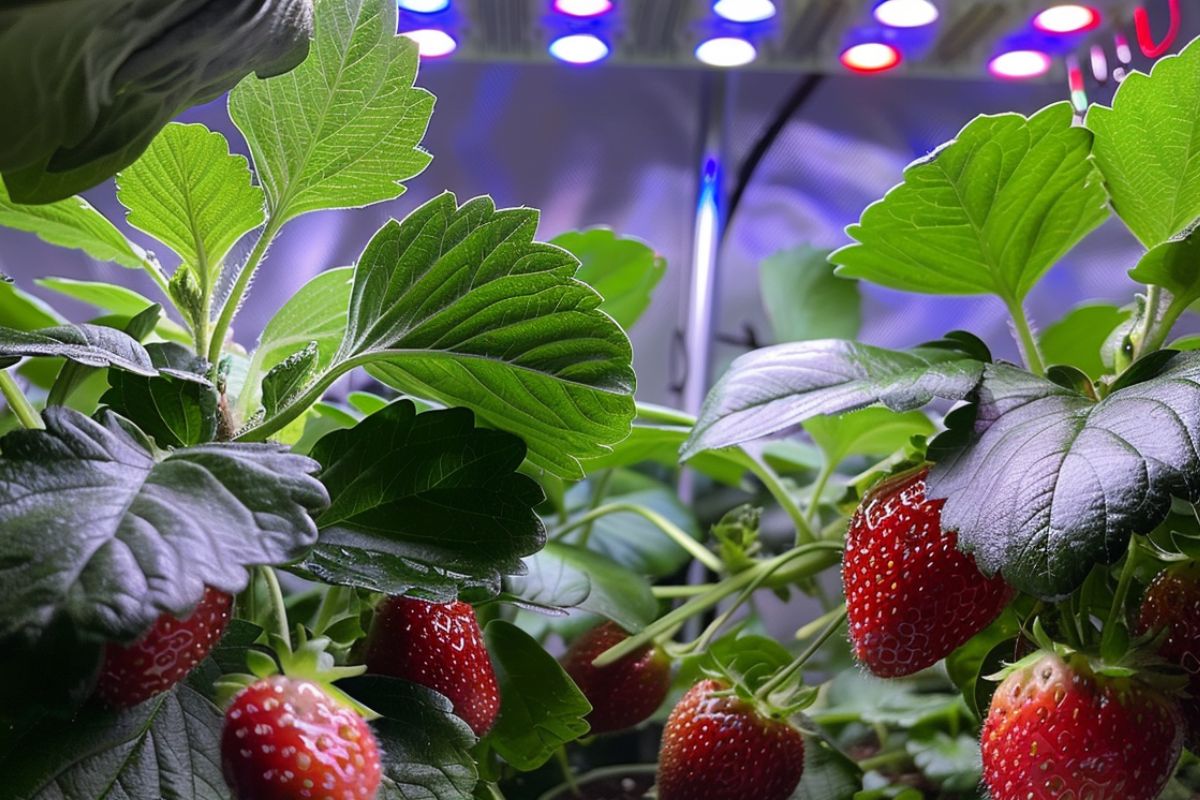Strawberries have long been valued as nature’s beloved produce. These succulent fruits not only capture taste buds but also offer several health benefits. They are packed with vitamins, antioxidants, and fiber.
Growing strawberries at home is a fun adventure. With an AeroGarden, you can have them fresh right in your kitchen. It’s pretty cool to watch them grow and then pick them when they’re ripe.
Let’s talk about how to grow these tasty treats in your AeroGarden. I’ll share some tricks I’ve learned to help you get the most out of your plants. Trust me, there’s nothing quite like biting into a strawberry you’ve grown yourself.
- Related article: What Are the Best Plants for AeroGarden
6 Key Takeaways on AeroGarden Strawberry
- AeroGarden doesn’t offer strawberry seed pods, but you can create your setup using AeroGarden Grow Anything Seed Pod Kits and strawberry crowns from garden centers or online.
- It takes about 4-6 weeks for strawberries to bear fruit in hydroponic systems. Good things come to those who wait!
- When planting strawberries, you need to sanitize your garden first, rinse strawberry crowns, fill the water tank appropriately, add Liquid Nutrients, and carefully thread roots through Grow Baskets.
- Keep Grow Lights 6-8 inches from your strawberry plant and maintain temperatures between 60°F to 80°F. You should also prune your plant to manage light exposure.
- Take care of your strawberry plant by maintaining water levels, following feeding schedules, and helping with pollination by gently brushing strawberry flowers.
- When harvesting, wait for fully ripe strawberries, harvest every few days, and use clean scissors to snip berries for continued growth and enjoyment.
What Fruit Seed Pod Kit Choices Are Offered by AeroGarden?
If you want to grow strawberries in your AeroGarden, it’s not as simple as popping in a pre-made pod like the rest. AeroGarden does not offer strawberry seed kits on their website now but don’t let that stop you! It’s easy to create your own setup. Trust me, it’s worth the extra effort.
Strawberry seeds take their sweet time before they’re ready to give you those plump produce. They typically take around 4-6 weeks to bear fruit in a hydroponic system. But hey, good things come to those who wait, right?
Here are the things that you need to gather to plant strawberries in your AeroGarden:
- AeroGarden Grow Anything Seed Pod Kits (view current prices)
- Strawberry crowns
- Any AeroGarden Indoor Garden Kit aside from the Sprout
We recommend that you use either Harvest, Bounty, or Farm models in growing strawberries as Sprout models do best with herbs.
Aerogarden doesn’t directly sell strawberry crowns, but these can be bought from garden centers or third-party sellers. Here are some great online selections:
- 10 Eversweet Everbearing Strawberry Plants (view prices)
- Honeoye Strawberry 10 Bare Root Plants (purchase now)
- Everbearing Ozark Beauty Strawberry Plants (see current price)
With a little TLC, you’ll be on your way to homegrown strawberries before you know it. Gardening is all about patience and persistence. So why not give it a shot? You might surprise yourself with your green thumb skills.
How Do You Plant Strawberry in the AeroGarden?

Now that you have everything you need to produce strawberries, let’s discuss how you can plant them on your AeroGarden. If you have used your AeroGarden previously, you will need to sanitize it before you plant another batch of crops. This is to make sure that any bacteria or algae from the previous plant is wiped clean.
Follow these steps to plant strawberry in your AeroGarden:
- First, you’ll need to unpack those strawberry crowns. They’re usually packed in dirt, so give them a gentle rinse with room-temperature water to clean them off.
- Fill the Grow Bowl to the “Fill to Here” line with tap water or distilled water. Skip the mineral or softened water as it might hurt your plants.
- Add Liquid Plant Food (shop now) to your AeroGarden. Follow the instructions on the nutrient bottle closely. You don’t want to over or underfeed your plants. It could mess with root growth.
- Thread your strawberry roots through the Grow Basket. The crown should sit on top. For smaller roots, you’ll need to prep a Grow Sponge. Cut it in half crosswise with scissors. If the roots are longer, cut them lower down. Tuck those plant roots into the sponge gently.
- Pop the Grow Baskets into the grow pod slots on your AeroGarden’s Grow Deck.
- Lower your Grow Light to its lowest position and keep adjusting it as your strawberries grow taller.
And there you have it. You’re all set to grow some delicious strawberries right in your kitchen.
How Do You Grow and Tend to Strawberries in the AeroGarden?

Growing strawberries in your AeroGarden is easier than you might think. With a bit of care, you could be enjoying them fresh for months. Let’s dive into how to nurture your plants for the best results.
- Watch Those Water and Nutrient Levels – Don’t let the water get too low. Your plants love fresh, clean water, so top it up often. When it comes to feeding time, stick to the script. Add exactly what the bottle says, every two weeks.
- Lights, Lights, Lights – Like when you grow Basil in an AeroGarden, grow lights should be 6-8 inches from the top of your strawberries. Tall plants need a gentle trim now and then to spread the light evenly. Watch out for leaves touching the lights as they’ll burn up fast.
- Maintain Temperature Levels – Strawberries like moderate temperatures. They like it between 60°F (15°C) and 80°F (27°C). Indoor growing usually keeps them safe from frost, but if it gets too cold, your plants might not make it.
- Prune Away – Pruning is pretty simple with strawberries. Just remove brown or dead leaves to keep mold away. If one plant is hogging all the light, give it a little trim to share the spotlight. Pruning results to bushier plants.
- Encourage Pollination – Indoor strawberries need a helping hand. When you see flowers, grab a soft brush and play bee. Gently brush from flower to flower.
Lastly, keep it clean. Rinse out your system monthly. With these tips, you’ll be well on your way to a large crop of juicy, homegrown strawberries.
How Do You Harvest Strawberries in the AeroGarden?
In just a month, you might be enjoying your first harvest. If you’ve chosen everbearing strawberries, you’re in for a treat. With proper care, you’ll get a second round of delicious fruits.
Here are some tips to keep your strawberry plant happy and healthy:
- Don’t get too excited! Wait until the strawberries are fully ripe
- Give your healthy plants a break and harvest every three days or more
- Use a pair of clean scissors to snip the strawberries off instead of pulling them
Your harvest can last up to three weeks, depending on the strawberry variety. That’s a lot of fresh fruit! One of the best things about using an AeroGarden is the “plant to plate” freshness. Now, you can pick the strawberries whenever you’re in the mood for a sweet snack.
AeroGarden Strawberry Final Thoughts
Growing strawberries in your AeroGarden is a fun project. You’ll need to be a bit creative this time since AeroGarden doesn’t sell pre-seeded strawberry pod kits. But don’t worry! It’s easy to make your own setup.
Once you’ve modified your AeroGarden setup, you’re all set to start your strawberry adventure. Just remember, with strawberries, patience is the name of the game. It usually takes 4-6 weeks for strawberry plants to bear fruit in hydroponic systems. But trust me, the wait is worth it!
Make sure to keep an eye on your plants daily. They’ll tell you what they need. If the leaves look droopy, they might need more water. If they’re pale, they might need more nutrients.
Ready to give it a try? There’s nothing quite like biting into a strawberry you’ve grown yourself. It’s sweet, juicy, and packed with pride. So what do you say? Your future strawberries are waiting for you to get started!
AeroGarden Strawberry FAQs
1. Can Strawberries Be Grown Hydroponically?
Definitely! Growing strawberries in a hydroponic system is easy. You don’t need a green thumb or prior experience to succeed. These juicy red fruits thrive in water-based setups, making them perfect for beginners and experts alike.
2. Are Strawberries Better Grown in Soil or Hydroponics?
In terms of output, you’ll see higher yields and better-looking strawberries in a hydroponic setup. This is due to the controlled environment that hydroponic systems have. Efficient nutrient delivery contributes well to your indoor garden’s output.
3. Are Hydroponic Strawberries Safe to Eat?
For sure they are! Strawberries grown hydroponically aren’t just tasty treats. They’re health powerhouses too! Did you know a single cup of these juicy gems packs more vitamin C than you need in a day? It’s true! You’ll get over 100% of your daily vitamin C from one serving.
Looking for other things to grow? Check these growing and harvest articles:




